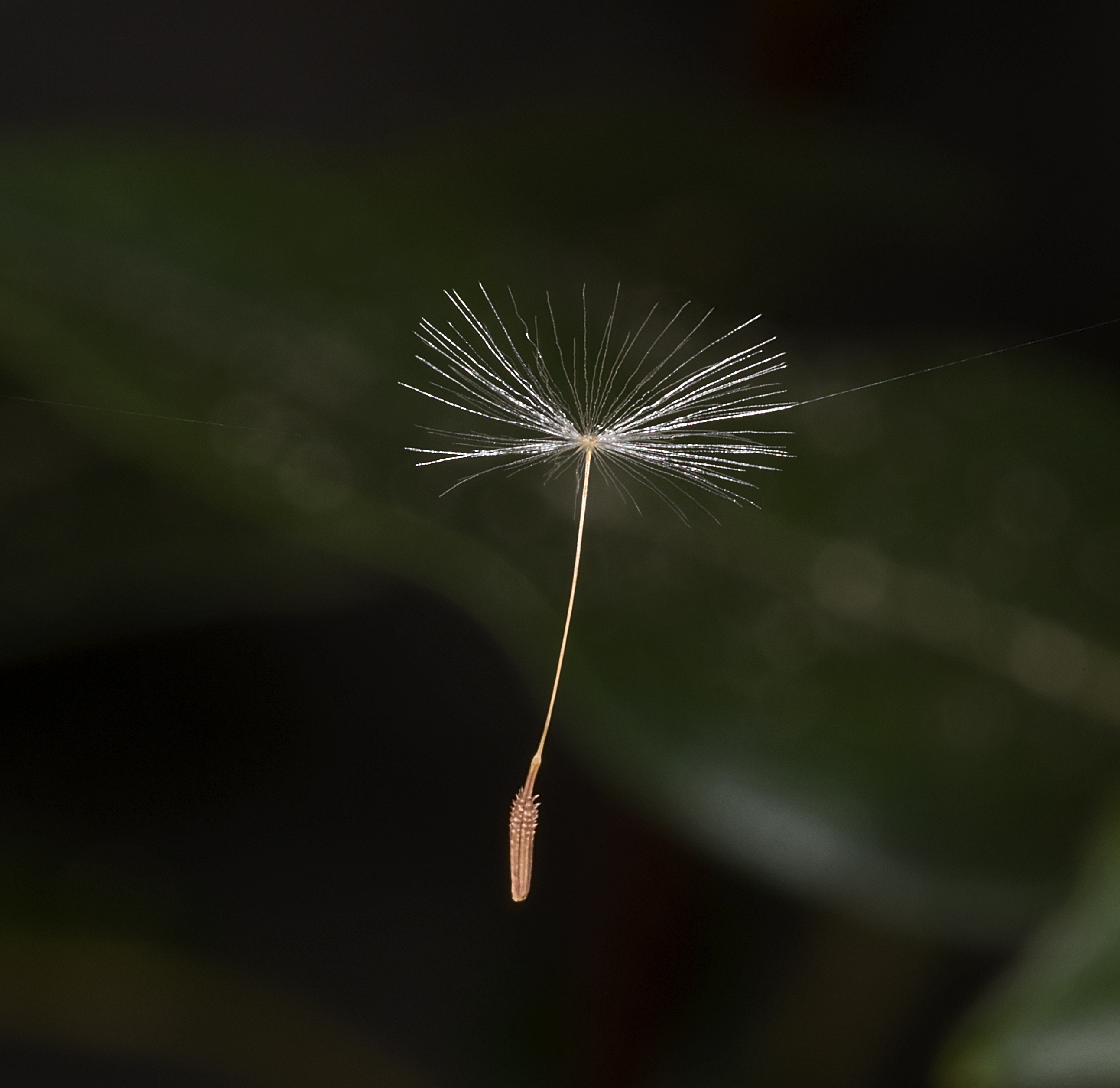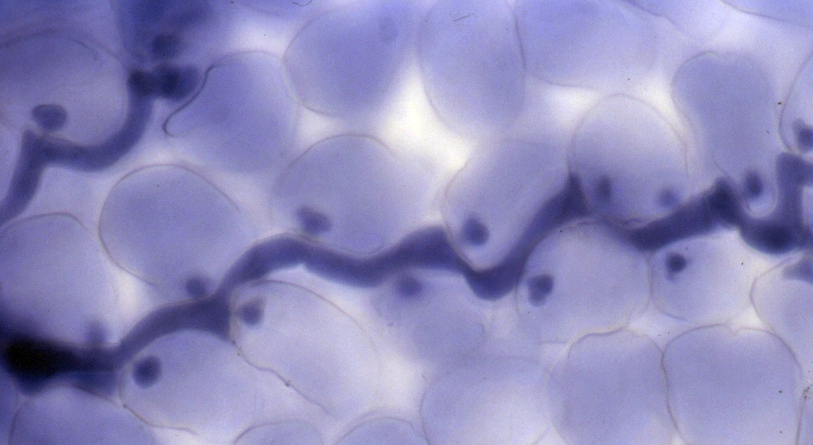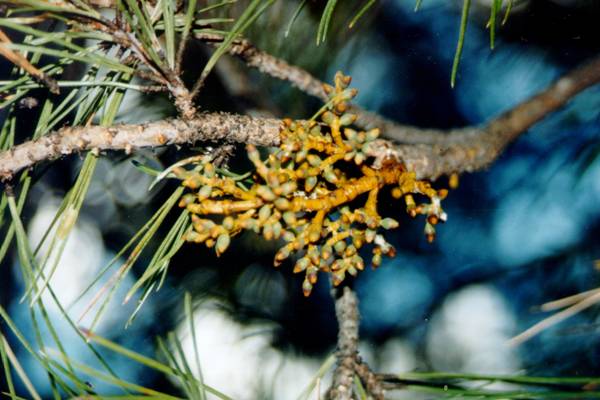|
Arceuthobium Douglasii
''Arceuthobium douglasii'' is a species of dwarf mistletoe known as Douglas fir dwarf mistletoe. It is native to western North America from British Columbia to Texas to California, where it lives in forest and woodland as a parasite. It is found mostly on Douglas fir (''Pseudotsuga menziesii'') trees, but occasionally on fir (''Abies'' spp.), as well.Hawksworth, F.G., & D. Wiens. 1993. Viscaceae, Mistletoe Family. Journal of the Arizona-Nevada Academy of Science 27:241-245Kuntze, K.E.O. Revisio Generum Plantarum 2: 587. 1891. This greenish shrub is visible as a network of scaly stems extending above the bark of its host tree. Most of the mistletoe is located inside the host tree, attached to it via haustoria, which tap the tree for water and nutrients. The leaves of the mistletoe are reduced to scales on its surface. It is dioecious, with male and female mistletoe plants producing spikes of staminate and pistillate flowers, respectively. The fruit is a sticky berry a few millimet ... [...More Info...] [...Related Items...] OR: [Wikipedia] [Google] [Baidu] |
George Engelmann
George Engelmann, also known as Georg Engelmann, (2 February 1809 – 4 February 1884) was a German-American botanist. He was instrumental in describing the flora (plants), flora of the west of North America, then very poorly known to Europeans; he was particularly active in the Rocky Mountains and northern Mexico, one of his constant companions being another German-American, the botanical illustrator Paulus Roetter. Biography Origins George Engelmann was born in Frankfurt am Main, Germany, the oldest of thirteen children, nine of whom reached maturity. His father, Julius Bernhardt Engelmann, was a member of a family from which for several successive generations were chosen ministers for the Reformed Church at Bacharach, Bacharach-on-the-Rhine. Julius was a graduate of the University of Halle, and was also educated for the ministry, but he devoted his life to education. He established a school for young women in Frankfurt, which was rare at the time. George Engelmann's mother, J ... [...More Info...] [...Related Items...] OR: [Wikipedia] [Google] [Baidu] |
Shrub
A shrub or bush is a small to medium-sized perennial woody plant. Unlike herbaceous plants, shrubs have persistent woody stems above the ground. Shrubs can be either deciduous or evergreen. They are distinguished from trees by their multiple Plant stem, stems and shorter height, less than tall. Small shrubs, less than tall are sometimes termed as subshrubs. Many botany, botanical groups have species that are shrubs, and others that are trees and herbaceous plants instead. Some define a shrub as less than and a tree as over 6 m. Others use as the cutoff point for classification. Many trees do not reach this mature height because of hostile, less than ideal growing conditions, and resemble shrub-sized plants. Others in such species have the potential to grow taller in ideal conditions. For longevity, most shrubs are classified between Perennial plant, perennials and trees. Some only last about five years in good conditions. Others, usually larger and more woody, live beyond ... [...More Info...] [...Related Items...] OR: [Wikipedia] [Google] [Baidu] |
Parasitic Plants
A parasitic plant is a plant that derives some or all of its nutritional requirements from another living plant. They make up about 1% of angiosperms and are found in almost every biome. All parasitic plants develop a specialized organ called the haustorium, which penetrates the host plant, connecting them to the host vasculature—either the xylem, phloem, or both. For example, plants like ''Striga'' or ''Rhinanthus'' connect only to the xylem, via xylem bridges (xylem-feeding). Alternately, plants like ''Cuscuta'' and some members of ''Orobanche'' connect to both the xylem and phloem of the host. This provides them with the ability to extract resources from the host. These resources can include water, nitrogen, carbon and/or sugars. Parasitic plants are classified depending on the location where the parasitic plant latches onto the host (root or stem), the amount of nutrients it requires, and their photosynthetic capability. Some parasitic plants can locate their host plants by ... [...More Info...] [...Related Items...] OR: [Wikipedia] [Google] [Baidu] |
Biological Dispersal
Biological dispersal refers to both the movement of individuals (animals, plants, fungi, bacteria, etc.) from their birth site to their breeding site ('natal dispersal') and the movement from one breeding site to another ('breeding dispersal'). Dispersal is also used to describe the movement of propagules such as seeds and spores. Technically, dispersal is defined as any movement that has the potential to lead to gene flow. The act of dispersal involves three phases: departure, transfer, and settlement. There are different fitness costs and benefits associated with each of these phases. Through simply moving from one habitat Landscape ecology#Patch and mosaic, patch to another, the dispersal of an individual has consequences not only for individual fitness (biology), fitness, but also for population dynamics, population genetics, and species distribution. Understanding dispersal and the consequences, both for evolutionary strategies at a species level and for processes at an e ... [...More Info...] [...Related Items...] OR: [Wikipedia] [Google] [Baidu] |
Gynoecium
Gynoecium (; ; : gynoecia) is most commonly used as a collective term for the parts of a flower that produce ovules and ultimately develop into the fruit and seeds. The gynoecium is the innermost whorl (botany), whorl of a flower; it consists of (one or more) ''#Pistil, pistils'' and is typically surrounded by the pollen-producing plant reproductive morphology, reproductive organs, the stamens, collectively called the androecium. The gynoecium is often referred to as the "female" portion of the flower, although rather than directly producing female gametes (i.e. egg cells), the gynoecium produces megaspores, each of which develops into a female gametophyte which then produces egg cells. The term gynoecium is also used by botanists to refer to a cluster of archegonia and any associated modified leaves or stems present on a gametophyte shoot in mosses, Marchantiophyta, liverworts, and hornworts. The corresponding terms for the male parts of those plants are clusters of antheridiu ... [...More Info...] [...Related Items...] OR: [Wikipedia] [Google] [Baidu] |
Stamen
The stamen (: stamina or stamens) is a part consisting of the male reproductive organs of a flower. Collectively, the stamens form the androecium., p. 10 Morphology and terminology A stamen typically consists of a stalk called the filament and an anther which contains sporangium, microsporangia. Most commonly, anthers are two-lobed (each lobe is termed a locule) and are attached to the filament either at the base or in the middle area of the anther. The sterile (i.e. nonreproductive) tissue between the lobes is called the Connective (botany), connective, an extension of the filament containing conducting strands. It can be seen as an extension on the dorsal side of the anther. A pollen grain develops from a microspore in the microsporangium and contains the male gametophyte. The size of anthers differs greatly, from a tiny fraction of a millimeter in ''Wolfia'' spp up to five inches (13 centimeters) in ''Canna iridiflora'' and ''Strelitzia nicolai''. The stamens in a flower ... [...More Info...] [...Related Items...] OR: [Wikipedia] [Google] [Baidu] |
Plant Sexuality
Plant reproductive morphology is the study of the physical form and structure (the morphology) of those parts of plants directly or indirectly concerned with sexual reproduction. Among all living organisms, flowers, which are the reproductive structures of angiosperms, are the most varied physically and show a correspondingly great diversity in methods of reproduction. Plants that are not flowering plants ( green algae, mosses, liverworts, hornworts, ferns and gymnosperms such as conifers) also have complex interplays between morphological adaptation and environmental factors in their sexual reproduction. The breeding system, or how the sperm from one plant fertilizes the ovum of another, depends on the reproductive morphology, and is the single most important determinant of the genetic structure of nonclonal plant populations. Christian Konrad Sprengel (1793) studied the reproduction of flowering plants and for the first time it was understood that the pollination pr ... [...More Info...] [...Related Items...] OR: [Wikipedia] [Google] [Baidu] |
Haustorium
In botany and mycology, a haustorium (plural haustoria) is a rootlike structure that grows into or around another structure to absorb water or nutrients. For example, in mistletoe or members of the broomrape family, the structure penetrates the host's tissue and draws nutrients from it. In mycology, it refers to the appendage or portion of a parasitic fungus (the hyphal tip), which performs a similar function. Microscopic haustoria penetrate the host plant's cell wall and siphon nutrients from the space between the cell wall and plasma membrane but do not penetrate the membrane itself. Larger (usually botanical, not fungal) haustoria do this at the tissue level. The etymology of the name corresponds to the Latin word '' haustor'' meaning ''the one who draws, drains or drinks'', and refers to the action performed by the outgrowth. In fungi Fungi in all major divisions form haustoria. Haustoria take several forms. Generally, on penetration, the fungus increases the surface ar ... [...More Info...] [...Related Items...] OR: [Wikipedia] [Google] [Baidu] |
Viscaceae
Viscaceae is a taxonomic family name of flowering plants. In this circumscription, the family includes the several genera of mistletoes. This family name is currently being studied and under review as in past decades, several systems of plant taxonomy recognized this family, notably the 1981 Cronquist system. However, the APG II system of 2003 does not recognize the family, treating it as a synonym of Santalaceae. This did not end the taxonomic debate among botanists and there are many that still think Viscaceae should be an accepted family name. According to the APG IV system, Der and Nickrent (2008) found seven well supported clades in Santalaceae, but relationships between these clades are still poorly understood. The traditional and cultural uses of species within the Viscaceae merit further attention. Clades or genera treated as belonging to the currently debated family name Viscaceae include: *''Arceuthobium The genus ''Arceuthobium'', commonly called dwarf mistleto ... [...More Info...] [...Related Items...] OR: [Wikipedia] [Google] [Baidu] |
Arceuthobium
The genus ''Arceuthobium'', commonly called dwarf mistletoes, is a genus of 42 species of parasitic plants that parasitize members of Pinaceae and Cupressaceae in North America, Central America, Asia, Europe, and Africa. Of the 42 species that have been recognized, 39 and 21 of these are endemic to North America and the United States, respectively. They all have very reduced shoots and leaves (mostly reduced to scales) with the bulk of the plant living under the host's bark. Recently the number of species within the genus has been reduced to 26 as a result of more detailed genetic analysis. Description They are plant sexuality, dioecious, individual plants being either male or female. The fruit is unusual in that it builds up hydrostatic pressure internally when ripe and shoots the single sticky seed up to speeds nearly , an example of rapid plant movement. The Arceuthobium americanum, lodgepole pine dwarf mistletoe,'' Arceuthobium americanum, has been found to explosively-disp ... [...More Info...] [...Related Items...] OR: [Wikipedia] [Google] [Baidu] |
Abies
Firs are evergreen coniferous trees belonging to the genus ''Abies'' () in the family Pinaceae. There are approximately 48–65 extant species, found on mountains throughout much of North and Central America, Eurasia, and North Africa. The genus is most closely related to '' Keteleeria'', a small genus confined to eastern Asia. The genus name is derived from the Latin "to rise" in reference to the height of its species. The common English name originates with the Old Norse ''fyri'' or the Old Danish ''fyr''. They are large trees, reaching heights of tall with trunk diameters of when mature. Firs can be distinguished from other members of the pine family by the way in which their needle-like leaves are attached singly to the branches with a base resembling a suction cup, and by their cones, which, like those of cedars, stand upright on the branches like candles and disintegrate at maturity. Identification of the different species is based on the size and arrangement o ... [...More Info...] [...Related Items...] OR: [Wikipedia] [Google] [Baidu] |
Pseudotsuga Menziesii
The Douglas fir (''Pseudotsuga menziesii'') is an evergreen conifer species in the pine family, Pinaceae. It is the tallest tree in the Pinaceae family. It is native plant, native to western North America and is also known as Douglas-fir, Douglas spruce, Oregon pine, and Columbian pine. There are three varieties: coast Douglas-fir (''P. menziesii'' var. ''menziesii''), Rocky Mountain Douglas-fir (''P. menziesii'' var. ''glauca'') and Mexican Douglas-fir (''P. menziesii'' var. ''lindleyana''). Despite its common names, it is not a true fir (genus ''Fir, Abies''), spruce (genus ''Spruce, Picea''), or pine (genus ''Pine, Pinus''). It is also not a Tsuga, hemlock; the genus name ''Pseudotsuga'' means "false hemlock". Description Douglas-firs are medium-sized to extremely large evergreen trees, tall (although only coast Douglas-firs reach heights near 100 m) and commonly reach in diameter, although trees with diameters of almost exist. The largest coast Douglas-firs regularl ... [...More Info...] [...Related Items...] OR: [Wikipedia] [Google] [Baidu] |







